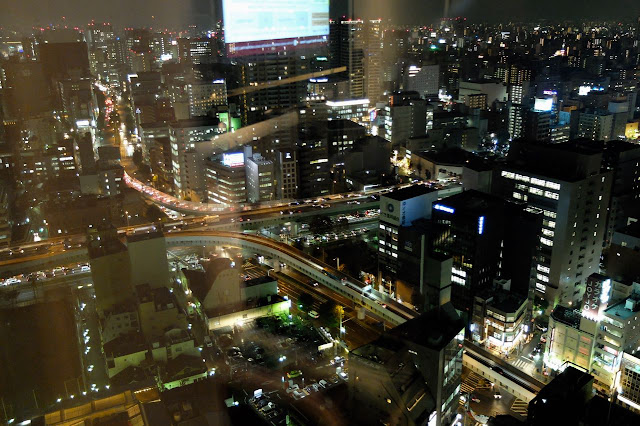We left Kyoto this morning by Shinkansen, heading east to our next stop: Nagoya, barely an hour's journey away by fast train. Nagoya is the birthplace of Toyota and pachinko (sorry Haruko) as well as being a manufacturing powerhouse. It looks very glossy and prosperous around Nagoya station and our Mitsui Gardens Hotel is super glossy and modern too. Nagoya is not known as a tourist hotspot but promises to be a good base for day trips (if the weather suits!).
Just behind our glossymodern hotel is an older area where we found a fresh seafood market just closing up for the day. But the market area incorporated quite a few busy lunch spots - all specialising in fresh seafood. We chose one where we thought we could recognise the dishes on the menu.
We chose well - a mixture of seafood and vegetables in tempura - some sashimi tuna and the usual rice and miso soup...all so fresh and delicious... a beautiful lunch.
We were very brave this afternoon and took a local train to the small district of Arimatsu, on the outskirts of Nagoya city. I have no idea how we managed it as Nagoya station is totally confusing and we were just guessing most of the time about what line we were on and what direction we were headed. We made it on to the right train eventually then were so lucky to be seated near a lovely lady who managed to work out we wanted to go to Arimatsu - her stop!! She guided us off the train and led us to the Shibori Museum - exactly where I was hoping we would end up.
Arimatsu was settled in the early 1600s along the old Tokaido Highway from Tokyo (Edo) to Kyoto. Villagers were all involved in making tie dyed cloth (called shibori) which they sold as cloths to the passing travellers. The craft of shibori in Arimatsu continues to this day. There are over a 100 tie dye patterns for shibori. They are all intricate and labour intensive.
Shibori is not just used for Kimonos and other clothing ......
Shibori is being adapted for contemporary clothing too by younger designers in the town.
There are still original houses along what was the old Tokaido Highway of Arimatsu.
Arimatsu was a quiet, low key place to visit; very interesting for me because of my interest in textiles and learning more about Japan. We were pretty pleased with ourselves for finding it and working out how to get there and for the small exchanges we had along the way with kind locals we were unable to speak to but with whom we had some connection.
Back on the 25th floor of the Mitsui Gardens Premier Nagoya....... It's close to Nagoya Station and connected to it by an underground passage. This is the view to the SW (I think!).
Just behind our glossymodern hotel is an older area where we found a fresh seafood market just closing up for the day. But the market area incorporated quite a few busy lunch spots - all specialising in fresh seafood. We chose one where we thought we could recognise the dishes on the menu.
We chose well - a mixture of seafood and vegetables in tempura - some sashimi tuna and the usual rice and miso soup...all so fresh and delicious... a beautiful lunch.
We were very brave this afternoon and took a local train to the small district of Arimatsu, on the outskirts of Nagoya city. I have no idea how we managed it as Nagoya station is totally confusing and we were just guessing most of the time about what line we were on and what direction we were headed. We made it on to the right train eventually then were so lucky to be seated near a lovely lady who managed to work out we wanted to go to Arimatsu - her stop!! She guided us off the train and led us to the Shibori Museum - exactly where I was hoping we would end up.
Arimatsu was settled in the early 1600s along the old Tokaido Highway from Tokyo (Edo) to Kyoto. Villagers were all involved in making tie dyed cloth (called shibori) which they sold as cloths to the passing travellers. The craft of shibori in Arimatsu continues to this day. There are over a 100 tie dye patterns for shibori. They are all intricate and labour intensive.
Shibori is not just used for Kimonos and other clothing ......
Shibori is being adapted for contemporary clothing too by younger designers in the town.
There are still original houses along what was the old Tokaido Highway of Arimatsu.
Arimatsu was a quiet, low key place to visit; very interesting for me because of my interest in textiles and learning more about Japan. We were pretty pleased with ourselves for finding it and working out how to get there and for the small exchanges we had along the way with kind locals we were unable to speak to but with whom we had some connection.
Back on the 25th floor of the Mitsui Gardens Premier Nagoya....... It's close to Nagoya Station and connected to it by an underground passage. This is the view to the SW (I think!).

















1 comment:
Another interesting day. Lovely to find the market for that fabulous looking lunch near your hotel...and how wonderful to find the shibori museum! No doubt a highlight for you Judy. xxx
Post a Comment